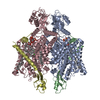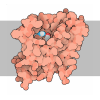+ Open data
Open data
- Basic information
Basic information
| Entry |  | |||||||||
|---|---|---|---|---|---|---|---|---|---|---|
| Title | Human ClC-3 | |||||||||
 Map data Map data | ||||||||||
 Sample Sample |
| |||||||||
 Keywords Keywords | Ion channel / membrane protein / lysosomal protein / CLC | |||||||||
| Function / homology |  Function and homology information Function and homology informationvolume-sensitive chloride channel activity / chloride:proton antiporter activity / synaptic vesicle lumen acidification / negative regulation of cell volume / endosomal lumen acidification / regulation of pH / voltage-gated chloride channel activity / specific granule / photoreceptor cell maintenance / vesicle membrane ...volume-sensitive chloride channel activity / chloride:proton antiporter activity / synaptic vesicle lumen acidification / negative regulation of cell volume / endosomal lumen acidification / regulation of pH / voltage-gated chloride channel activity / specific granule / photoreceptor cell maintenance / vesicle membrane / antiporter activity / phagocytosis, engulfment / synaptic transmission, GABAergic / positive regulation of reactive oxygen species biosynthetic process / chloride channel activity / phagocytic vesicle / axon terminus / chloride transmembrane transport / secretory granule / adult locomotory behavior / synaptic transmission, glutamatergic / PDZ domain binding / Stimuli-sensing channels / recycling endosome / GABA-ergic synapse / ruffle membrane / synaptic vesicle / synaptic vesicle membrane / late endosome membrane / late endosome / cytoplasmic vesicle / early endosome membrane / early endosome / endosome membrane / Golgi membrane / lysosomal membrane / external side of plasma membrane / intracellular membrane-bounded organelle / glutamatergic synapse / cell surface / Golgi apparatus / ATP binding / membrane / plasma membrane Similarity search - Function | |||||||||
| Biological species |  Homo sapiens (human) Homo sapiens (human) | |||||||||
| Method | single particle reconstruction / cryo EM / Resolution: 2.54 Å | |||||||||
 Authors Authors | Schrecker M / Son Y / Hite RK | |||||||||
| Funding support |  United States, 2 items United States, 2 items
| |||||||||
 Citation Citation |  Journal: bioRxiv / Year: 2025 Journal: bioRxiv / Year: 2025Title: Structural basis of ClC-3 inhibition by TMEM9 and PI(3,5)P. Authors: Marina Schrecker / Yeeun Son / Rosa Planells-Cases / Sumanta Kar / Viktoriia Vorobeva / Uwe Schulte / Bernd Fakler / Thomas J Jentsch / Richard K Hite /   Abstract: The trafficking and activity of endosomes relies on the exchange of chloride ions and protons by members of the CLC family of chloride channels and transporters, whose mutations are associated with ...The trafficking and activity of endosomes relies on the exchange of chloride ions and protons by members of the CLC family of chloride channels and transporters, whose mutations are associated with numerous diseases. Despite their critical roles, the mechanisms by which CLC transporters are regulated are poorly understood. Here, we show that two related accessory β-subunits, TMEM9 and TMEM9B, directly interact with ClC-3, -4 and -5. Cryo-EM structures reveal that TMEM9 inhibits ClC-3 by sealing the cytosolic entrance to the Cl ion pathway. Unexpectedly, we find that PI(3,5)P stabilizes the interaction between TMEM9 and ClC-3 and is required for proper regulation of ClC-3 by TMEM9. Collectively, our findings reveal that TMEM9 and PI(3,5)P collaborate to regulate endosomal ion homeostasis by modulating the activity of ClC-3. | |||||||||
| History |
|
- Structure visualization
Structure visualization
| Supplemental images |
|---|
- Downloads & links
Downloads & links
-EMDB archive
| Map data |  emd_47070.map.gz emd_47070.map.gz | 107.3 MB |  EMDB map data format EMDB map data format | |
|---|---|---|---|---|
| Header (meta data) |  emd-47070-v30.xml emd-47070-v30.xml emd-47070.xml emd-47070.xml | 20.8 KB 20.8 KB | Display Display |  EMDB header EMDB header |
| FSC (resolution estimation) |  emd_47070_fsc.xml emd_47070_fsc.xml | 12.6 KB | Display |  FSC data file FSC data file |
| Images |  emd_47070.png emd_47070.png | 101.9 KB | ||
| Masks |  emd_47070_msk_1.map emd_47070_msk_1.map | 216 MB |  Mask map Mask map | |
| Filedesc metadata |  emd-47070.cif.gz emd-47070.cif.gz | 6.6 KB | ||
| Others |  emd_47070_half_map_1.map.gz emd_47070_half_map_1.map.gz emd_47070_half_map_2.map.gz emd_47070_half_map_2.map.gz | 200 MB 200 MB | ||
| Archive directory |  http://ftp.pdbj.org/pub/emdb/structures/EMD-47070 http://ftp.pdbj.org/pub/emdb/structures/EMD-47070 ftp://ftp.pdbj.org/pub/emdb/structures/EMD-47070 ftp://ftp.pdbj.org/pub/emdb/structures/EMD-47070 | HTTPS FTP |
-Validation report
| Summary document |  emd_47070_validation.pdf.gz emd_47070_validation.pdf.gz | 905.6 KB | Display |  EMDB validaton report EMDB validaton report |
|---|---|---|---|---|
| Full document |  emd_47070_full_validation.pdf.gz emd_47070_full_validation.pdf.gz | 905 KB | Display | |
| Data in XML |  emd_47070_validation.xml.gz emd_47070_validation.xml.gz | 21.9 KB | Display | |
| Data in CIF |  emd_47070_validation.cif.gz emd_47070_validation.cif.gz | 28.4 KB | Display | |
| Arichive directory |  https://ftp.pdbj.org/pub/emdb/validation_reports/EMD-47070 https://ftp.pdbj.org/pub/emdb/validation_reports/EMD-47070 ftp://ftp.pdbj.org/pub/emdb/validation_reports/EMD-47070 ftp://ftp.pdbj.org/pub/emdb/validation_reports/EMD-47070 | HTTPS FTP |
-Related structure data
| Related structure data |  9do0MC  9dnwC  9dnxC  9dnyC  9dnzC M: atomic model generated by this map C: citing same article ( |
|---|---|
| Similar structure data | Similarity search - Function & homology  F&H Search F&H Search |
- Links
Links
| EMDB pages |  EMDB (EBI/PDBe) / EMDB (EBI/PDBe) /  EMDataResource EMDataResource |
|---|---|
| Related items in Molecule of the Month |
- Map
Map
| File |  Download / File: emd_47070.map.gz / Format: CCP4 / Size: 216 MB / Type: IMAGE STORED AS FLOATING POINT NUMBER (4 BYTES) Download / File: emd_47070.map.gz / Format: CCP4 / Size: 216 MB / Type: IMAGE STORED AS FLOATING POINT NUMBER (4 BYTES) | ||||||||||||||||||||||||||||||||||||
|---|---|---|---|---|---|---|---|---|---|---|---|---|---|---|---|---|---|---|---|---|---|---|---|---|---|---|---|---|---|---|---|---|---|---|---|---|---|
| Projections & slices | Image control
Images are generated by Spider. | ||||||||||||||||||||||||||||||||||||
| Voxel size | X=Y=Z: 0.826 Å | ||||||||||||||||||||||||||||||||||||
| Density |
| ||||||||||||||||||||||||||||||||||||
| Symmetry | Space group: 1 | ||||||||||||||||||||||||||||||||||||
| Details | EMDB XML:
|
-Supplemental data
-Mask #1
| File |  emd_47070_msk_1.map emd_47070_msk_1.map | ||||||||||||
|---|---|---|---|---|---|---|---|---|---|---|---|---|---|
| Projections & Slices |
| ||||||||||||
| Density Histograms |
-Half map: #2
| File | emd_47070_half_map_1.map | ||||||||||||
|---|---|---|---|---|---|---|---|---|---|---|---|---|---|
| Projections & Slices |
| ||||||||||||
| Density Histograms |
-Half map: #1
| File | emd_47070_half_map_2.map | ||||||||||||
|---|---|---|---|---|---|---|---|---|---|---|---|---|---|
| Projections & Slices |
| ||||||||||||
| Density Histograms |
- Sample components
Sample components
-Entire : Human ClC-3
| Entire | Name: Human ClC-3 |
|---|---|
| Components |
|
-Supramolecule #1: Human ClC-3
| Supramolecule | Name: Human ClC-3 / type: complex / ID: 1 / Parent: 0 / Macromolecule list: #1 |
|---|---|
| Source (natural) | Organism:  Homo sapiens (human) Homo sapiens (human) |
-Macromolecule #1: H(+)/Cl(-) exchange transporter 3
| Macromolecule | Name: H(+)/Cl(-) exchange transporter 3 / type: protein_or_peptide / ID: 1 / Number of copies: 2 / Enantiomer: LEVO |
|---|---|
| Source (natural) | Organism:  Homo sapiens (human) Homo sapiens (human) |
| Molecular weight | Theoretical: 91.054977 KDa |
| Recombinant expression | Organism:  Homo sapiens (human) Homo sapiens (human) |
| Sequence | String: MESEQLFHRG YYRNSYNSIT SASSDEELLD GAGVIMDFQT SEDDNLLDGD TAVGTHYTMT NGGSINSSTH LLDLLDEPIP GVGTYDDFH TIDWVREKCK DRERHRRINS KKKESAWEMT KSLYDAWSGW LVVTLTGLAS GALAGLIDIA ADWMTDLKEG I CLSALWYN ...String: MESEQLFHRG YYRNSYNSIT SASSDEELLD GAGVIMDFQT SEDDNLLDGD TAVGTHYTMT NGGSINSSTH LLDLLDEPIP GVGTYDDFH TIDWVREKCK DRERHRRINS KKKESAWEMT KSLYDAWSGW LVVTLTGLAS GALAGLIDIA ADWMTDLKEG I CLSALWYN HEQCCWGSNE TTFEERDKCP QWKTWAELII GQAEGPGSYI MNYIMYIFWA LSFAFLAVSL VKVFAPYACG SG IPEIKTI LSGFIIRGYL GKWTLMIKTI TLVLAVASGL SLGKEGPLVH VACCCGNIFS YLFPKYSTNE AKKREVLSAA SAA GVSVAF GAPIGGVLFS LEEVSYYFPL KTLWRSFFAA LVAAFVLRSI NPFGNSRLVL FYVEYHTPWY LFELFPFILL GVFG GLWGA FFIRANIAWC RRRKSTKFGK YPVLEVIIVA AITAVIAFPN PYTRLNTSEL IKELFTDCGP LESSSLCDYR NDMNA SKIV DDIPDRPAGI GVYSAIWQLC LALIFKIIMT VFTFGIKVPS GLFIPSMAIG AIAGRIVGIA VEQLAYYHHD WFIFKE WCE VGADCITPGL YAMVGAAACL GGVTRMTVSL VVIVFELTGG LEYIVPLMAA VMTSKWVGDA FGREGIYEAH IRLNGYP FL DAKEEFTHTT LAADVMRPRR NDPPLAVLTQ DNMTVDDIEN MINETSYNGF PVIMSKESQR LVGFALRRDL TIAIESAR K KQEGIVGSSR VCFAQHTPSL PAESPRPLKL RSILDMSPFT VTDHTPMEIV VDIFRKLGLR QCLVTHNGRL LGIITKKDI LRHMAQTANQ DPASIMFN UniProtKB: H(+)/Cl(-) exchange transporter 3 |
-Macromolecule #2: CHLORIDE ION
| Macromolecule | Name: CHLORIDE ION / type: ligand / ID: 2 / Number of copies: 4 / Formula: CL |
|---|---|
| Molecular weight | Theoretical: 35.453 Da |
-Macromolecule #3: CHOLESTEROL
| Macromolecule | Name: CHOLESTEROL / type: ligand / ID: 3 / Number of copies: 4 / Formula: CLR |
|---|---|
| Molecular weight | Theoretical: 386.654 Da |
| Chemical component information |  ChemComp-CLR: |
-Macromolecule #4: water
| Macromolecule | Name: water / type: ligand / ID: 4 / Number of copies: 104 / Formula: HOH |
|---|---|
| Molecular weight | Theoretical: 18.015 Da |
| Chemical component information |  ChemComp-HOH: |
-Experimental details
-Structure determination
| Method | cryo EM |
|---|---|
 Processing Processing | single particle reconstruction |
| Aggregation state | particle |
- Sample preparation
Sample preparation
| Concentration | 3 mg/mL | |||||||||||||||
|---|---|---|---|---|---|---|---|---|---|---|---|---|---|---|---|---|
| Buffer | pH: 8 Component:
Details: 0.02% GDN, 50 mM Tris-HCl (pH 8), 150 mM KCl, 2 mM DTT | |||||||||||||||
| Grid | Model: Quantifoil R1.2/1.3 / Material: GOLD / Mesh: 400 / Support film - Material: CARBON / Support film - topology: HOLEY | |||||||||||||||
| Vitrification | Cryogen name: ETHANE / Chamber humidity: 100 % / Chamber temperature: 297 K / Instrument: FEI VITROBOT MARK IV |
- Electron microscopy
Electron microscopy
| Microscope | FEI TITAN KRIOS |
|---|---|
| Image recording | Film or detector model: GATAN K3 (6k x 4k) / Average exposure time: 3.0 sec. / Average electron dose: 66.0 e/Å2 |
| Electron beam | Acceleration voltage: 300 kV / Electron source:  FIELD EMISSION GUN FIELD EMISSION GUN |
| Electron optics | Illumination mode: FLOOD BEAM / Imaging mode: BRIGHT FIELD / Nominal defocus max: 2.0 µm / Nominal defocus min: 0.7000000000000001 µm |
| Experimental equipment |  Model: Titan Krios / Image courtesy: FEI Company |
+ Image processing
Image processing
-Atomic model buiding 1
| Refinement | Space: REAL / Protocol: BACKBONE TRACE / Target criteria: FSC 0.5 |
|---|---|
| Output model |  PDB-9do0: |
 Movie
Movie Controller
Controller









 Z (Sec.)
Z (Sec.) Y (Row.)
Y (Row.) X (Col.)
X (Col.)













































